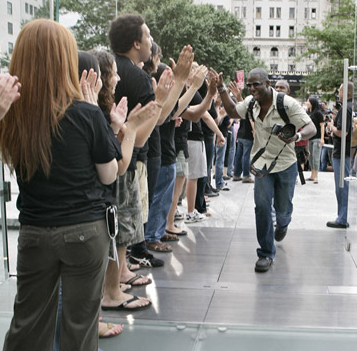This is part III of a series on Common Pitfalls of Building Social Web Applications. Read Part I and Part II
8) Not Enabling Recommendations
Thoughtful recommendations are the best possible way to increase your user base. It is word-of-mouth in action. When someone takes time out of their day to say something really nice about your service, making an honest-to-goodness recommendation, you will definitely see positive results. The question is, are you making it easy for your users to recommend you?
In our world lots of people make recommendations, but many of them are paid to do so or are looking after their own interests. Take, for example, the Publisher’s book descriptions on Amazon.com. These are always super-positive…they explain why the book is so great and why you should buy it. They would never contain anything negative, never contain anything that might potentially hurt the sales of the book.
And, as a result, the book description tells us exactly what we would expect from a publisher. To Amazon’s credit, they have over time given individual reviews and ratings more prominence on the product page, signaling that that content is more valuable to users. And of course it should be…those people aren’t biased in the way the publishing house is.
 Many sites add incentives for recommendations so that people give them more freely. Netflix, for example, allows you to give “free movies” to friends while you tell them about the service. This is a good approach. Netflix does not reward you for this…the act of giving is all that you get. If Netflix did give you a free movie that would introduce too much bias…and while more people might make recommendations it would quickly turn into a case similar to the publishers…as people would realize that there is something in it for the recommender.
Many sites add incentives for recommendations so that people give them more freely. Netflix, for example, allows you to give “free movies” to friends while you tell them about the service. This is a good approach. Netflix does not reward you for this…the act of giving is all that you get. If Netflix did give you a free movie that would introduce too much bias…and while more people might make recommendations it would quickly turn into a case similar to the publishers…as people would realize that there is something in it for the recommender.
Continue Reading: Common Pitfalls of Building Social Web Applications and How to Avoid Them, Part 3
 Many sites add incentives for recommendations so that people give them more freely. Netflix, for example, allows you to give “free movies” to friends while you tell them about the service. This is a good approach. Netflix does not reward you for this…the act of giving is all that you get. If Netflix did give you a free movie that would introduce too much bias…and while more people might make recommendations it would quickly turn into a case similar to the publishers…as people would realize that there is something in it for the recommender.
Many sites add incentives for recommendations so that people give them more freely. Netflix, for example, allows you to give “free movies” to friends while you tell them about the service. This is a good approach. Netflix does not reward you for this…the act of giving is all that you get. If Netflix did give you a free movie that would introduce too much bias…and while more people might make recommendations it would quickly turn into a case similar to the publishers…as people would realize that there is something in it for the recommender.  The blog is interesting for several reasons, most notably the candidness of the posts. In this post on
The blog is interesting for several reasons, most notably the candidness of the posts. In this post on 